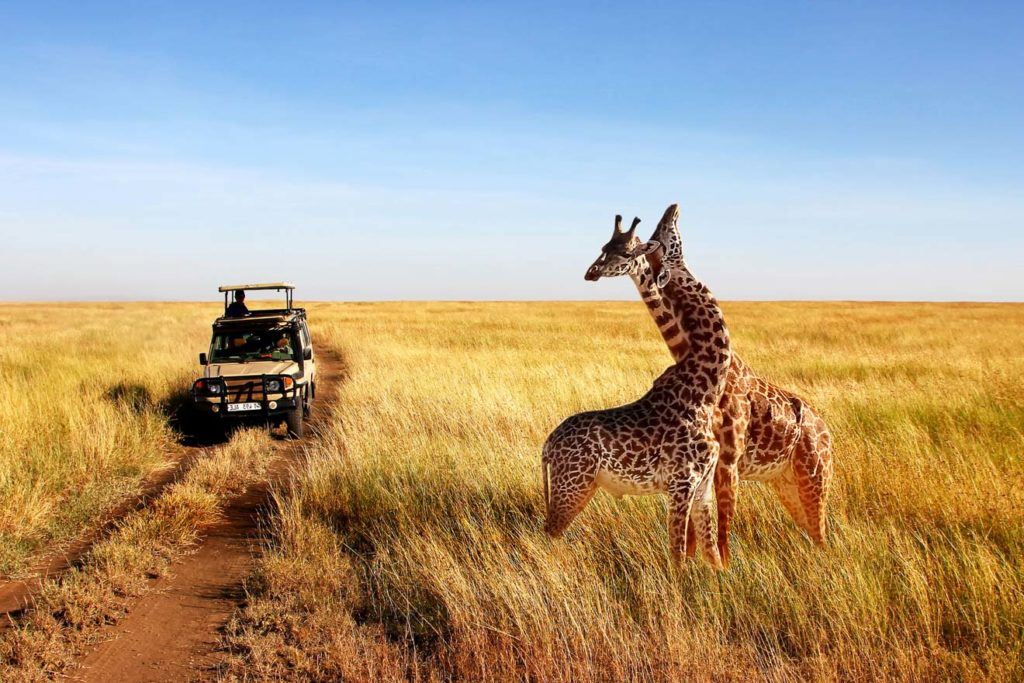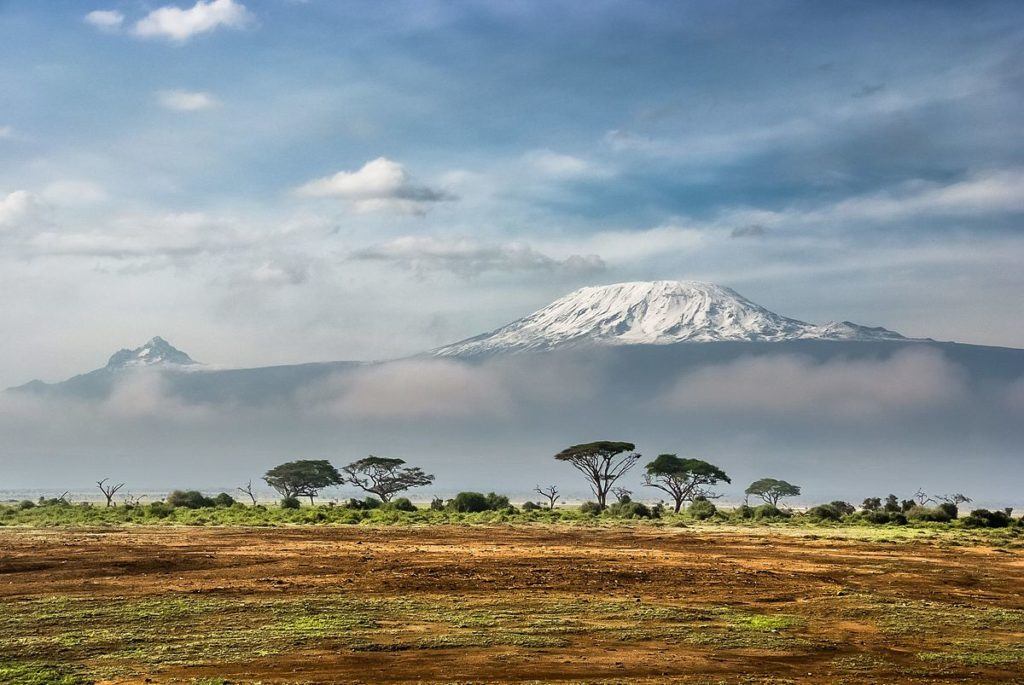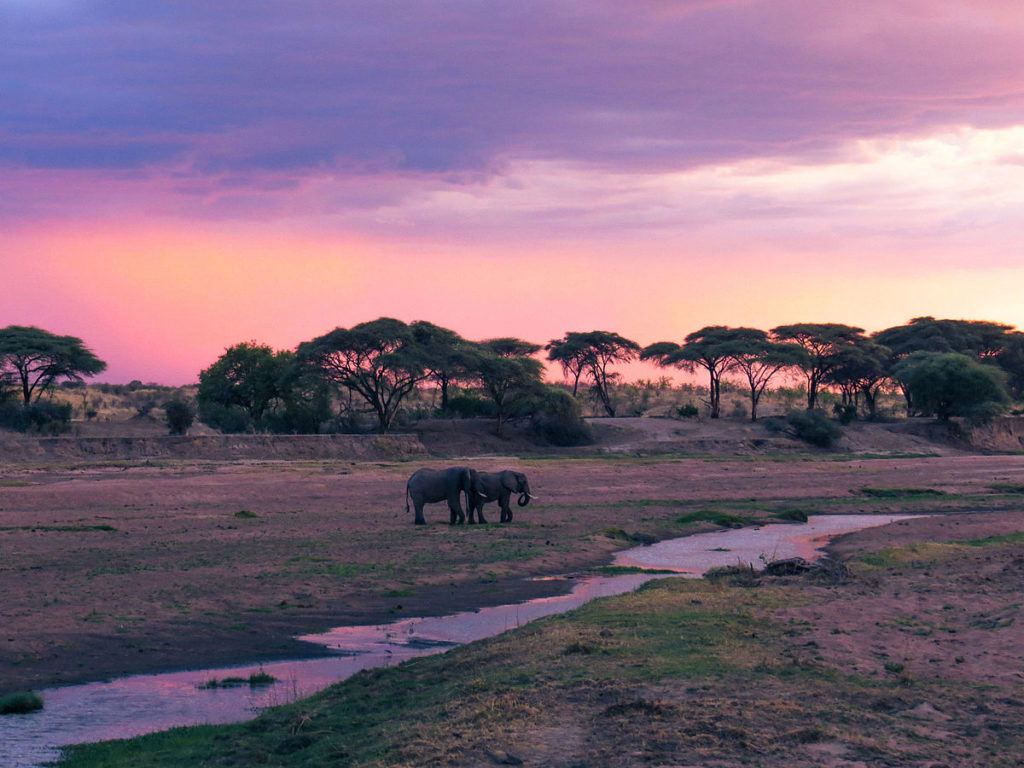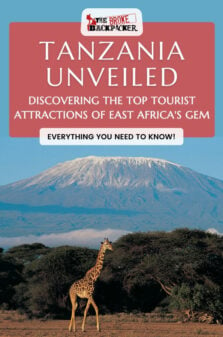The Broke Backpacker is supported by you. Clicking through our links may earn us a small affiliate commission, and that's what allows us to keep producing free content 🙂 Learn more.
Tanzania is an absolute gem of East Africa just waiting to be unveiled. Take it from me, I spent my 18th birthday there climbing to the top of Kilimanjaro.
But there is so much more to Tanzania that just Kilimanjaro. In fact, embarking on a journey to Tanzania is like stepping into a beautifully vivid living postcard, with its boundless skies, sprawling savannahs and scores of wildlife.
However, the country is so very rich and vast that deciding what to see and do there can feel nothing short of overwhelming.
Well, in this comprehensive guide to Tanzania, we’ll take you through the top, not to miss tourist attractions that make Tanzania a must-visit destination.
Let’s get into it!

The Broke Backpacker is supported by you. Clicking through our links may earn us a small affiliate commission, and that's what allows us to keep producing free content 🙂 Learn more.
The Serengeti Plains
The world famous Serengeti National Park is not just a park rather it is a vast ecosystem that spans over 14,000 square kilometres. Its iconic savannah grasslands are home to some amazing and diverse wildlife, including Africas Big Five (lion, leopard, elephant, buffalo, and rhinoceros). This makes it one of the continents best destination for wildlife enthusiasts and safari tourists.
However, what truly sets the Serengeti apart is the Great Migration – an annual spectacle of nature where millions of wildebeest, zebras, and gazelles move across the plains in search of fresh grazing grounds and water. This annual event is a true treat for those lucky enough to catch it.
Conservation at Its Core
Preserving the Serengeti’s biodiversity and beauty is a monumental task that requires continuous effort and international collaboration. Conservation organisations work absolutely tirelessly in trying conditions to combat poaching, to protect habitats, and to promote sustainable tourism practices.
Visitors can contribute to these efforts by supporting eco-friendly lodges, participating in guided safaris led by knowledgeable guides, and respecting the park’s rules and regulations.
Mount Kilimanjaro

Mount Kilimanjaro, standing tall at 5,895 metres, is not just a mountain. Nope it is a symbol of human endurance and determination! Climbing Kilimanjaro is a bona-fide bucket-list worthy experience for many adventurers and there are multiple routes to the top all with varying degrees of difficulty.
The journey to the summit is as much about mental resolve as it is about physical fitness and climbers will be rewarded with awe-inspiring views and a true sense of proper accomplishment.
Cultural Significance
For the native Chagga people, who have lived in Kilimanjaro’s foothills for centuries, Kilimanjaro holds deep cultural and spiritual significance. Ancient and traditional rituals and ceremonies are still practised here, highlighting the harmonious relationship between humans and nature.
However, Kilimanjaro’s glaciers are sadly receding due to climate change, underscoring the urgent need for environmental conservation and sustainable tourism practices.
Psssttt – Did you know that Broke Backpacker founder Will Hatton scaled Kilimanjaro on his 18th birthday?!
Zanzibar Archipelago
The Zanzibar Archipelago is a mosaic of islands off the coast of Tanzania each with distinct identities. Zanzibar Island, the largest in the archipelago, is primarily renowned for its white sandy beaches, crystal-clear waters, and vibrant colourful coral reefs. Visitors here can engage in classic Tanzania activities like snorkelling, diving, and sailing, exploring the underwater world that is teeming with marine life.
Spice of Life
Zanzibar’s spice trade history has left a lasting delicious culinary legacy on the region. Visitors can join spice tours which showcase the island’s aromatic treasures like cloves, cinnamon, and vanilla. The fusion of African, Arab, and Indian influences is evident in every mouthful of Zanzibar’s delightful cuisine which never fails to tantalise taste buds with exotic flavours and traditional dishes.
Preserving Heritage
Stone Town, Zanzibar’s historic quarter, is a UNESCO World Heritage site known for its labyrinthine alleys, ornate doors, and unique blend of Swahili, Arab, Persian, and European architecture. One of my favorite things to do in Zanzibar is to just wander these beautiful streets.
Efforts to preserve Stone Town’s heritage sites and promote sustainable tourism are ongoing and are crucial for safeguarding its cultural legacy.
Ngorongoro Crater
The Ngorongoro Crater is a geological marvel and a bit of haven for wildlife enthusiasts. This ancient volcanic caldera harbours a pretty diverse ecosystem, with grasslands, forests, and even a soda lake providing habitat for many species, including lions, elephants, hippos, and flamingos.
The crater’s unique geography also creates a natural amphitheatre, offering some unparalleled wildlife viewing and photography opportunities. This one is not to be missed.
Balancing Conservation and Tourism
Seen as the crater itself is pretty solid and secure, conservation efforts in the Ngorongoro Conservation Area mostly focus on preserving biodiversity, managing human-wildlife interactions, and promoting sustainable land use practices.
Responsible tourism initiatives, such as limited vehicle access and controlled visitor numbers, all help to minimise environmental impact.
Tarangire National Park
Tarangire National Park is often called the “Elephant Playground” due to its large elephant population. Beyond the elephants though, the park is a hotspot for wildlife diversity, with buffalo, giraffes, zebras, and various antelope species living on its vast savannahs and acacia woodlands. Each year thousands of birdwatchers flock to Tarangire for its rich avian diversity, including species like the yellow-collared lovebird.
Community Engagement
Community-based tourism initiatives in Tarangire are primarily intended to empower local communities by providing employment opportunities, supporting education and healthcare initiatives. Visitors can participate in guided walks with Maasai guides, visit traditional villages, and learn about conservation efforts.
Cultural Experiences in Tanzania
Tanzania’s rich and unique cultural tapestry is woven from diverse ethnic groups, many languages, and whole host of traditions. The Maasai people, known for their distinctive dress, pastoral lifestyle and choral music, offer insights into traditional ways of life through cultural tours and homestays.
Historic towns like Bagamoyo and Kilwa Kisiwani along the Swahili Coast showcase the region’s maritime history and architectural wonders.
Music and dance are also integral to Tanzanian culture. From traditional drums’ rhythmic beats to ngoma dance performances’ energetic movements, visitors can immerse themselves in vibrant expressions of creativity and identity all while getting their boogie on.
Final Thoughts

Tanzania’s top tourist attractions are not just places to visit; they are experiences that leave a deep and lasting impact on travellers.
But remember, the previous ecosystems here need our help so there most definitely is a right way to visit Tanzania. By embracing sustainable tourism practices, supporting conservation initiatives, and respecting local cultures, visitors can ensure that Tanzania’s natural and cultural treasures remain accessible for future generations.
So pack your bags, embark on an unforgettable journey, and discover the magic of Tanzania, East Africa’s gem waiting to be explored.
Did you find this post helpful? If so, let us know in the comments below!
Buy Us a Coffee!
A couple of you lovely readers suggested we set up a tip jar for direct support as an alternative to booking through our links. So we created one!
You can now buy The Broke Backpacker a coffee. If you like and use our content to plan your trips, it’s a much appreciated way to show appreciation 🙂






